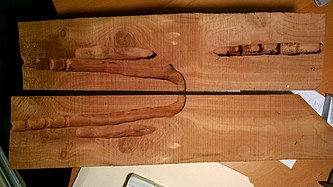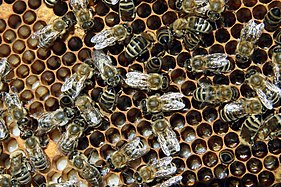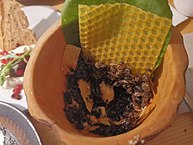Bee
| Bees Temporal range: Late Cretaceous – Present
| |
|---|---|

| |
| The sugarbag bee, Tetragonula carbonaria | |
| Scientific classification | |
| Domain: | Eukaryota |
| Kingdom: | Animalia |
| Phylum: | Arthropoda |
| Class: | Insecta |
| Order: | Hymenoptera |
| (unranked): | Unicalcarida
|
| Suborder: | Apocrita |
| Superfamily: | Apoidea |
| Clade: | Anthophila |
| Families | |
| Synonyms | |
|
Apiformes (from Latin 'apis') | |
Bees are winged insects closely related to wasps and ants, known for their roles in pollination and, in the case of the best-known bee species, the western honey bee, for producing honey. Bees are a monophyletic lineage within the superfamily Apoidea. They are currently considered a clade, called Anthophila.[1] There are over 20,000 known species of bees in seven recognized biological families.[2][3][4] Some species – including honey bees, bumblebees, and stingless bees – live socially in colonies while most species (>90%) – including mason bees, carpenter bees, leafcutter bees, and sweat bees – are solitary.
Bees are found on every continent except Antarctica, in every habitat on the planet that contains insect-pollinated flowering plants. The most common bees in the Northern Hemisphere are the Halictidae, or sweat bees, but they are small and often mistaken for wasps or flies. Bees range in size from tiny stingless bee species, whose workers are less than 2 millimetres (0.08 in) long,[5] to Megachile pluto, the largest species of leafcutter bee, whose females can attain a length of 39 millimetres (1.54 in).
Bees feed on
.Bee pollination is important both ecologically and commercially, and the decline in wild bees has increased the value of pollination by commercially managed hives of honey bees. The analysis of 353 wild bee and hoverfly species across Britain from 1980 to 2013 found the insects have been lost from a quarter of the places they inhabited in 1980.[6]
Human
Evolution
The immediate ancestors of bees were stinging wasps in the family Crabronidae, which were predators of other insects. The switch from insect prey to pollen may have resulted from the consumption of prey insects which were flower visitors and were partially covered with pollen when they were fed to the wasp larvae. This same evolutionary scenario may have occurred within the vespoid wasps, where the pollen wasps evolved from predatory ancestors.
Based on phylogenetic analysis, bees are thought to have originated during the Early Cretaceous (about 124 million years ago) on the supercontinent of West Gondwana, just prior to its breakup into South America and Africa. The supercontinent is thought to have been a largely xeric environment at this time; modern bee diversity hotspots are also in xeric and seasonal temperate environments, suggesting strong niche conservatism among bees ever since their origins.[7]
Genomic analysis indicates that despite only appearing much later in the fossil record, all modern bee families had already diverged from one another by the end of the Cretaceous. The Melittidae, Apidae, and Megachilidae had already evolved on the supercontinent prior to its fragmentation. Further divergences were facilitated by West Gondwana's breakup around 100 million years ago, leading to a deep Africa-South America split within both the Apidae and Megachilidae, the isolation of the Melittidae in Africa, and the origins of the Colletidae, Andrenidae and Halictidae in South America. The rapid radiation of the South American bee families is thought to have followed the concurrent radiation of flowering plants in the same region. Later in the Cretaceous (80 million years ago), colletid bees colonized Australia from South America (with an offshoot lineage evolving into the Stenotritidae), and by the end of the Cretaceous, South American bees had also colonized North America.[7] The North American fossil taxon Cretotrigona belongs to a group that is no longer found in North America, suggesting that many bee lineages went extinct during the Cretaceous-Paleogene extinction event.[7]
Following the K-Pg extinction, surviving bee lineages continued to spread into the Northern Hemisphere, colonizing Europe from Africa by the Paleocene, and then spreading east to Asia. This was facilitated by the warming climate around the same time, allowing bees to move to higher latitudes following the spread of tropical and subtropical habitats. By the Eocene (~45 mya) there was already considerable diversity among eusocial bee lineages.[8][a] A second extinction event among bees is thought to have occurred due to rapid climatic cooling around the Eocene-Oligocene boundary, leading to the extinction of some bee lineages such as the tribe Melikertini. Over the Paleogene and Neogene, different bee lineages continued to spread all over the world, and the shifting habitats and connectedness of continents led to the isolation and evolution of many new bee tribes.[7]
Fossils
The oldest non-compression bee fossil is Cretotrigona prisca, a corbiculate bee of Late Cretaceous age (~70 mya) found in New Jersey amber.[11] A fossil from the early Cretaceous (~100 mya), Melittosphex burmensis, was initially considered "an extinct lineage of pollen-collecting Apoidea sister to the modern bees",[12] but subsequent research has rejected the claim that Melittosphex is a bee, or even a member of the superfamily Apoidea to which bees belong, instead treating the lineage as incertae sedis within the Aculeata.[13]
The Allodapini (within the Apidae) appeared around 53 Mya.[14] The Colletidae appear as fossils only from the late Oligocene (~25 Mya) to early Miocene.[15] The Melittidae are known from Palaeomacropis eocenicus in the Early Eocene.[16] The Megachilidae are known from trace fossils (characteristic leaf cuttings) from the Middle Eocene.[17] The Andrenidae are known from the Eocene-Oligocene boundary, around 34 Mya, of the Florissant shale.[18] The Halictidae first appear in the Early Eocene[19] with species[20][21] found in amber. The Stenotritidae are known from fossil brood cells of Pleistocene age.[22]
Coevolution

The earliest animal-pollinated flowers were shallow, cup-shaped blooms
Phylogeny
External
This
| Apoidea |
| ||||||||||||||||||||||||||||||||||||||||||
Internal
This cladogram of the bee families is based on Hedtke et al., 2013, which places the former families Dasypodaidae and Meganomiidae as subfamilies inside the Melittidae.[28] English names, where available, are given in parentheses.
Anthophila (bees)
|
| |||||||||||||||||||||||||||||||||||||||
Characteristics

Bees differ from closely related groups such as wasps by having branched or plume-like setae (hairs), combs on the forelimbs for cleaning their antennae, small anatomical differences in limb structure, and the venation of the hind wings; and in females, by having the seventh dorsal abdominal plate divided into two half-plates.[29]
Bees have the following characteristics:
- A pair of large ocelli) which provide information on light intensity.
- The antennae usually have 13 segments in males and 12 in females, and are geniculate, having an elbow joint part way along. They house large numbers of sense organs that can detect touch (mechanoreceptors), smell and taste; and small, hairlike mechanoreceptors that can detect air movement so as to "hear" sounds.
- The mouthparts are adapted for both chewing and sucking by having both a pair of mandibles and a long proboscis for sucking up nectar.[30]
- The thorax has three segments, each with a pair of robust legs, and a pair of membranous wings on the hind two segments. The front legs of corbiculate bees bear combs for cleaning the antennae, and in many species the hind legs bear pollen baskets, flattened sections with incurving hairs to secure the collected pollen. The wings are synchronised in flight, and the somewhat smaller hind wings connect to the forewings by a row of hooks along their margin which connect to a groove in the forewing.
- The abdomen has nine segments, the hindermost three being modified into the sting.[30]
The largest species of bee is thought to be Wallace's giant bee
Sociality
Haplodiploid breeding system
According to
In haplodiploid species, females develop from fertilized eggs and males from unfertilized eggs. Because a male is
Haplodiploidy is neither necessary nor sufficient for eusociality. Some eusocial species such as
Eusociality

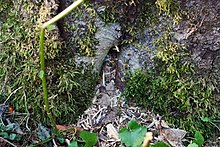
Bees may be solitary or may live in various types of communities.
True honey bees (genus

Many bumblebees are eusocial, similar to the eusocial Vespidae such as hornets in that the queen initiates a nest on her own rather than by swarming. Bumblebee colonies typically have from 50 to 200 bees at peak population, which occurs in mid to late summer. Nest architecture is simple, limited by the size of the pre-existing nest cavity, and colonies rarely last more than a year.[42] In 2011, the International Union for Conservation of Nature set up the Bumblebee Specialist Group to review the threat status of all bumblebee species worldwide using the IUCN Red List criteria.[43]
There are many more species of primitively eusocial than highly eusocial bees, but they have been studied less often. Most are in the family
Solitary and communal bees

Most other bees, including familiar insects such as
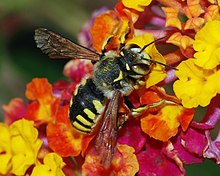
Most solitary bees are fossorial, digging nests in the ground in a variety of soil textures and conditions, while others create nests in hollow reeds or twigs, or holes in wood. The female typically creates a compartment (a "cell") with an egg and some provisions for the resulting larva, then seals it off. A nest may consist of numerous cells. When the nest is in wood, usually the last (those closer to the entrance) contain eggs that will become males. The adult does not provide care for the brood once the egg is laid, and usually dies after making one or more nests. The males typically emerge first and are ready for mating when the females emerge. Solitary bees are very unlikely to sting (only in self-defense, if ever), and some (esp. in the family Andrenidae) are stingless.[49][50]

While solitary, females each make individual nests.[51] Some species, such as the European mason bee Hoplitis anthocopoides,[52] and the Dawson's Burrowing bee, Amegilla dawsoni,[53] are gregarious, preferring to make nests near others of the same species, and giving the appearance of being social. Large groups of solitary bee nests are called aggregations, to distinguish them from colonies. In some species, multiple females share a common nest, but each makes and provisions her own cells independently. This type of group is called "communal" and is not uncommon. The primary advantage appears to be that a nest entrance is easier to defend from predators and parasites when multiple females use that same entrance regularly.[52]
Biology
Life cycle
The life cycle of a bee, be it a solitary or social species, involves the laying of an egg, the development through several moults of a legless larva, a pupation stage during which the insect undergoes complete metamorphosis, followed by the emergence of a winged adult. The number of eggs laid by a female during her lifetime can vary from eight or less in some solitary bees, to more than a million in highly social species.[54] Most solitary bees and bumble bees in temperate climates overwinter as adults or pupae and emerge in spring when increasing numbers of flowering plants come into bloom. The males usually emerge first and search for females with which to mate. Like the other members of Hymenoptera bees are haplodiploid; the sex of a bee is determined by whether or not the egg is fertilised. After mating, a female stores the sperm, and determines which sex is required at the time each individual egg is laid, fertilised eggs producing female offspring and unfertilised eggs, males. Tropical bees may have several generations in a year and no diapause stage.[55][56][57][58]
The egg is generally oblong, slightly curved and tapering at one end. Solitary bees, lay each egg in a separate cell with a supply of mixed pollen and nectar next to it. This may be rolled into a pellet or placed in a pile and is known as mass provisioning. Social bee species provision progressively, that is, they feed the larva regularly while it grows. The nest varies from a hole in the ground or in wood, in solitary bees, to a substantial structure with wax combs in bumblebees and honey bees.[59]
In most species, larvae are whitish grubs, roughly oval and bluntly-pointed at both ends. They have 15 segments and
-
Nest ofpupaein irregularly placed wax cells
-
Carpenter bee nests in a cedar wood beam (sawn open)
-
Honeybees onlarvaein cells
Flight
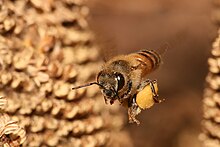

The ethologist Karl von Frisch studied navigation in the honey bee. He showed that honey bees communicate by the waggle dance, in which a worker indicates the location of a food source to other workers in the hive. He demonstrated that bees can recognize a desired compass direction in three different ways: by the Sun, by the polarization pattern of the blue sky, and by the Earth's magnetic field. He showed that the Sun is the preferred or main compass; the other mechanisms are used under cloudy skies or inside a dark beehive.[66] Bees navigate using spatial memory with a "rich, map-like organization".[67]
Digestion
The gut of bees is relatively simple, but multiple metabolic strategies exist in the gut microbiota.[68] Pollinating bees consume nectar and pollen, which require different digestion strategies by somewhat specialized bacteria. While nectar is a liquid of mostly monosaccharide sugars and so easily absorbed, pollen contains complex polysaccharides: branching pectin and hemicellulose.[69] Approximately five groups of bacteria are involved in digestion. Three groups specialize in simple sugars (Snodgrassella and two groups of Lactobacillus), and two other groups in complex sugars (Gilliamella and Bifidobacterium). Digestion of pectin and hemicellulose is dominated by bacterial clades Gilliamella and Bifidobacterium respectively. Bacteria that cannot digest polysaccharides obtain enzymes from their neighbors, and bacteria that lack certain amino acids do the same, creating multiple ecological niches.[70]
Although most bee species are nectarivorous and palynivorous, some are not. Particularly unusual are vulture bees in the genus Trigona, which consume carrion and wasp brood, turning meat into a honey-like substance.[71]
Ecology
Floral relationships
Most bees are polylectic (generalist) meaning they collect pollen from a range of flowering plants, but some are
In rare cases, a plant species may only be effectively pollinated by a single bee species, and some plants are endangered at least in part because their pollinator is also threatened. But, there is a pronounced tendency for oligolectic bees to be associated with common, widespread plants visited by multiple pollinator species. For example, the creosote bush in the arid parts of the United States southwest is associated with some 40 oligoleges.[77]
As mimics and models
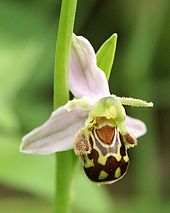
Many bees are
Bees are themselves Müllerian mimics of other aposematic insects with the same colour scheme, including wasps, lycid and other beetles, and many butterflies and moths (Lepidoptera) which are themselves distasteful, often through acquiring bitter and poisonous chemicals from their plant food. All the Müllerian mimics, including bees, benefit from the reduced risk of predation that results from their easily recognised warning coloration.[79]
Bees are also mimicked by plants such as the bee orchid which imitates both the appearance and the scent of a female bee; male bees attempt to mate (pseudocopulation) with the furry lip of the flower, thus pollinating it.[80]
As brood parasites
In Southern Africa, hives of African honeybees (A. mellifera scutellata) are being destroyed by parasitic workers of the Cape honeybee, A. m. capensis. These lay
The
Nocturnal bees
Four bee families (
Predators, parasites and pathogens
Vertebrate predators of bees include
Specialist ambush predators of visitors to flowers include
Some mites of genus Tarsonemus are associated with bees. They live in bee nests and ride on adult bees for dispersal. They are presumed to feed on fungi, nest materials or pollen. However, the impact they have on bees remains uncertain.[95]
Symbiosis of Mycelium and Bees
Fungus properties
Recent studies have shown that
Bee broods
The symbiotic relationship between bees and mycelium is found primarily in Brazilian stingless bees and Malaysian stingless bees - or more commonly honey bees. Bee broods are the larvae of honeybees. They can typically be found inside of a bee hive, and in man made hives especially, the honeybees can be found developing at different stages (eggs, larvae, and pupae) inside a hexagonal shape. Bee larvae are incapable of producing steroids at birth, so they ingest mycelium to receive vital nutrients they cannot create on their own such as ecdysteroids and Zygosaccharomyces sp.[98] Once the honey bee eggs hatch, a white microbial film starts to grow on the boundary between the brood cell and the larval food supply, and is then ingested by the larvae to complete their development.[98]
Gut microbiota play an immense role in the health of the entire bee colony. Three studies were recently conducted and each introduced a new organism to the bees gut microbiota. The bees were fed aged pollen, the assembly of the gut microbiota was disturbed, and antibiotic tetracycline entered their diet. All three studies showed that the honey bees' ability to survive decreased drastically and they became more likely to contract parasites and fungal infections.[99] The introduction of certain mycelium to the honey bees gut microbiota has the opposite effect to what took place in these three studies, highlighting the importance of what bees ingest and the impacts it has on their survivability during both the development and adult stages.
Bee-fungus symbiosis
As mentioned above, honey bees cannot produce steroids themselves, they must be ingested through their diet, specifically in the early development process. Larvae eat the fungus and the ecdysteroids and Zygosaccharomyces produced by the mycelium benefit the larvae. Ecdysteroids are naturally occurring steroids found in mycelium and they help enhance performance and reproduction, boosting honey production and keeping the hive population running at a stable rate. “Zygosaccharomyces sp. is essential for S. depilis larvae”.[98] These sterols thus have a high impact on the survival rate of honey bees. Their ingestion determines whether the honey bees will be able to protect themselves against fungal infections, viruses, and whether or not they will have sufficient strength to increase honey production and the ability to pollinate a larger area and more frequently.
Knowledge of how mycelium boosts honey bees immunity could be pivotal to the increase of a honey bee's lifespan and boost reproduction by helping implement new policies to prevent the use of harmful pesticides.[98]
Impact of pesticides
Pesticides have been diminishing the bee population recently due to a lack of regulations regarding what can and cannot be sprayed on produce to protect it from being damaged during growth. When honey bees collect pollen and nectar for nutrition and to make honey, they are also ingesting harmful chemicals. Such chemicals take a toll on the honey bees' already sensitive gut microbiome and lead to a higher morbidity rate in honey bees. "These microbes can suffer with toxic pesticides applied in agriculture, causing dangerous changes in the colony fitness and perturbing bees' health.” (Yordanova, M. et al., 2022)[100]
With the research provided on the positive impact of mycelium on bees, the relationship between mycelium and honey bees is symbiotic in that the survival of bees and the mycelium's ability to help boost bee pollination, boosts the ability of the fungi to grow because bee pollination improves air and soil quality, thus boosting plant life. Allowing for a higher survivability rate for both bees and mycelium if they are able to perform their environmental roles properly without the interruption of harmful government approved pesticides. The recent studies done on the symbiotic relationship between mycelium and honey bees will prove to be vital in the argument towards lessening the types of chemicals legally allowed to be sprayed on produce. The use of pesticides on lawns and for other agricultural uses destroy the livelihood of mycelium by killing the soil it grows in, inhibiting bees from ingesting the necessary nutrients mycelium provides to survive.
Relationship with humans
In mythology and folklore
The image of a community of honey bees has been used from ancient to modern times, in
In art and literature
Some of the oldest examples of bees in art are rock paintings in Spain which have been dated to 15,000 BC.[105]
The 2007 animated comedy film Bee Movie used Jerry Seinfeld's first script and was his first work for children; he starred as a bee named Barry B. Benson, alongside Renée Zellweger. Critics found its premise awkward and its delivery tame.[107] Dave Goulson's A Sting in the Tale (2014) describes his efforts to save bumblebees in Britain, as well as much about their biology. The playwright Laline Paull's fantasy The Bees (2015) tells the tale of a hive bee named Flora 717 from hatching onwards.[108]
Beekeeping


Humans have kept honey bee colonies, commonly in hives, for millennia. Beekeepers collect honey, beeswax, propolis, pollen, and royal jelly from hives; bees are also kept to pollinate crops and to produce bees for sale to other beekeepers.
Depictions of humans collecting honey from wild bees date to 15,000 years ago; efforts to domesticate them are shown in Egyptian art around 4,500 years ago.[109] Simple hives and smoke were used;[110][111] jars of honey were found in the tombs of pharaohs such as Tutankhamun.
Among Classical Era authors, beekeeping with the use of smoke is described in Aristotle's History of Animals Book 9.[112] The account mentions that bees die after stinging; that workers remove corpses from the hive, and guard it; castes including workers and non-working drones, but "kings" rather than queens; predators including toads and bee-eaters; and the waggle dance, with the "irresistible suggestion" of άροσειονται ("aroseiontai", it waggles) and παρακολουθούσιν ("parakolouthousin", they watch).[113][b]
Beekeeping is described in detail by Virgil in his Georgics; it is also mentioned in his Aeneid, and in Pliny's Natural History.[113]
From the 18th century, European understanding of the colonies and biology of bees allowed the construction of the moveable comb hive so that honey could be harvested without destroying the colony.[114][115]
As commercial pollinators
Role of bees
Bees play an important role in pollinating flowering plants, and are the major type of pollinator in many ecosystems that contain flowering plants. It is estimated that one third of the human food supply depends on pollination by insects, birds and bats, most of which is accomplished by bees, whether wild or domesticated.[116][117] Over the last half century, there has been a general decline in the species richness of wild bees and other pollinators, probably attributable to stress from increased parasites and disease, the use of pesticides, and a general decrease in the number of wild flowers. Climate change probably exacerbates the problem.[118]
In the United States
In the European Union
Apart from colony collapse disorder, losses outside the US have been attributed to causes including pesticide seed dressings, using
Raising native plants
Farmers have focused on alternative solutions to mitigate these problems. By raising native plants, they provide food for native bee pollinators like Lasioglossum vierecki[134] and L. leucozonium,[135] leading to less reliance on honey bee populations.
-
Bee covered in pollen
As food producers
Honey is a natural product produced by bees and stored for their own use, but its sweetness has always appealed to humans. Before domestication of bees was even attempted, humans were raiding their nests for their honey. Smoke was often used to subdue the bees and such activities are depicted in rock paintings in Spain dated to 15,000 BC.[105]
Honey bees are used commercially to produce honey.[136] They also produce some substances used as dietary supplements with possible health benefits, pollen,[137] propolis,[138] and royal jelly,[139] though all of these can also cause allergic reactions.
As food
Bees are considered
Bee brood (pupae and larvae) although low in
-
Bee larvae as food in the Javanese dish botok tawon
-
Fried whole bees served in a Ukrainian restaurant
As alternative medicine
Stings
The painful
See also
Explanatory notes
- ^ Triassic nests in a petrified forest in Arizona, implying that bees evolved much earlier,[9] are now thought to be beetle borings.[10]
- ^ In D'Arcy Thompson's translation: "At early dawn they make no noise, until some one particular bee makes a buzzing noise two or three times and thereby awakes the rest; hereupon they all fly in a body to work. By and by they return and at first are noisy; ... until at last some one bee flies round about, making a buzzing noise, and apparently calling on the others to go to sleep".[112]
References
- ^ Engel, M. S. (2005) Family-group names for bees (Hymenoptera, Apoidea). American Museum Novitates 3476.
- PMID 17015826.
- ^ ISBN 0-8018--6133-0.
- PMID 37506702.
- ^ S2CID 227250633.
- ^ "Widespread losses of pollinating insects revealed across Britain". The Guardian. 26 March 2019.
- ^ PMID 37506702.
- PMID 11172007.
- ^ ISBN 978-1-59726-908-7. Archivedfrom the original on 27 May 2016.
- .
- PMID 21695157.
- S2CID 28047407. Archived from the original(PDF) on 4 December 2012.
- S2CID 234071940.
- S2CID 28274420.
- (PDF) from the original on 21 September 2013.
- (PDF) from the original on 23 September 2015.
- hdl:11336/100644. Archived(PDF) from the original on 24 September 2015.
- PMID 24715773.
- (PDF) from the original on 12 August 2017.
- JSTOR 25010174.
- (PDF) from the original on 10 January 2011.
- ^ Houston, T.F. (1987). "Fossil brood cells of stenotritid bees (Hymenoptera: Apoidea) from the Pleistocene of South Australia". Transactions of the Royal Society of South Australia. 1111–2: 93–97. Archived from the original on 1 July 2015.
- ^ Armbruster, W. Scott (2012). "3". In Patiny, Sébastien (ed.). Evolution of Plant-Pollinator Relationships. Cambridge University Press. pp. 45–67.
- ^ ISBN 978-0-674-81175-1.
- (PDF) from the original on 28 March 2018.
- ^ (PDF) from the original on 4 May 2019.
- (PDF) from the original on 23 September 2015.
- PMID 23822725.
- ^ ISBN 978-0-521-82149-0. Archivedfrom the original on 28 March 2018.
- ^ a b "Anatomy of the Honey Bee". Extension. 19 June 2014. Archived from the original on 1 July 2015. Retrieved 30 June 2015.
- JSTOR 25084498.
- ^ Sakagami, Shôichi F.; Zucchi, Ronaldo (1974). "Oviposition Behavior of Two Dwarf Stingless Bees, Hypotrigona (Leurotrigona) muelleri and H. (Trigonisca) duckei, with Notes on the Temporal Articulation of Oviposition Process in Stingless Bees" (PDF). Journal of the Faculty of Science Hokkaido University Series Vi. Zoology. 19 (2): 361–421. Archived (PDF) from the original on 4 March 2016.
- S2CID 20388889.
- PMID 5875340.
- ^ S2CID 20388889.
- ISBN 978-1-118-84615-5.
- PMID 20740005.
- PMID 16769636.
- ^ Wilson, Edward O (1971). The Insect Societies. Cambridge, Mass: Belknap Press of Harvard University Press.
- ^ Sanford, Malcolm T. (2006). "The Africanized Honey Bee in the Americas: A Biological Revolution with Human Cultural Implications". Apis Enterprises. Archived from the original on 29 March 2015. Retrieved 29 March 2015.
- (PDF) from the original on 9 October 2022.
- ^ "Bumblebee nests". Bumblebee Conservation Trust. Archived from the original on 22 September 2017. Retrieved 26 June 2015.
- IUCN. Archived(PDF) from the original on 3 December 2012. Retrieved 7 October 2012.
- ^ Brooks, R. W.; Roubik, D. W. (1983). "A Halictine bee with distinct castes: Halictus hesperus (Hymenoptera: Halictidae) and its bionomics in Central Panama". Sociobiology. 7: 263–282.
- S2CID 12868253.
- S2CID 44934383.
- ISBN 978-0-674-81175-1. Archivedfrom the original on 24 December 2016.
- ^ Parker, Frank D.; Torchio, Philip F. (1 October 1980). "Management of Wild Bees". Beesource Beekeeping Community. Archived from the original on 26 June 2015. Retrieved 26 June 2015.
- ^ "Solitary Bees (Hymenoptera)". Royal Entomological Society. Archived from the original on 2 July 2017. Retrieved 12 October 2015.
- ^ "Other bees". Bumblebee Conservation Trust. Archived from the original on 5 September 2015. Retrieved 12 October 2015.
- ^ Westreich, Lila (May 2020). "Spring signals female bees to lay the next generation of pollinators". The Conversation. Retrieved 8 October 2020.
- ^ PMID 28563288.
- S2CID 24832889.
- ^ The Bees of the World, Volum 1
- ISBN 978-0-521-42909-2. Archivedfrom the original on 17 June 2016.
- ^ "The bumblebee lifecycle". Bumblebee Conservation Trust. Archived from the original on 29 June 2015. Retrieved 1 July 2015.
- ^ "Learning About Honey Bees". The South Carolina Mid-State Beekeepers Association. Archived from the original on 1 July 2015. Retrieved 1 July 2015.
- ^ "Solitary Bees". National Bee Unit. Archived from the original on 1 July 2015. Retrieved 1 July 2015.
- ^ a b Shuckard, William Edward (1866). British bees: an introduction to the study of the natural history and economy of the bees indigenous to the British Isles. L. Reeve & Co. pp. 18–23.
- ISBN 0716741202.
- ^ Adams, Cecil (4 May 1990). "Is it aerodynamically impossible for bumblebees to fly?". The Straight Dope. Archived from the original on 3 March 2009. Retrieved 7 March 2009.
- ^ "Life, animal and plant news, articles and features". New Scientist. 9 March 2016. Archived from the original on 7 October 2008. Retrieved 16 March 2016.
- ^ "Images of flight". New Scientist. Archived from the original on 23 March 2016. Retrieved 16 March 2016.
- ^ "Deciphering the Mystery of Bee Flight". California Institute of Technology. 29 November 2005. Archived from the original on 17 September 2016. Retrieved 8 September 2016. Re: work of Dr. Michael H. Dickinson.
- PMID 16330767.
- ^ von Frisch, Karl (1953). The Dancing Bees. Harcourt, Brace & World. pp. 93–96.
- PMID 15710880.
- ^ "How honey bee gut bacteria help to digest their pollen-rich diet". ScienceDaily. Retrieved 2 January 2020.
- ^ "Bee gut microbes have a division of labor when it comes to metabolizing complex polysaccharides". phys.org. Retrieved 2 January 2020.
- PMID 31776248.
- S2CID 26518321.
- ISBN 978-0-226-87400-5. Archivedfrom the original on 28 March 2018.
- PMID 20047869.
- ^ ISBN 978-3-7091-6306-1. Archivedfrom the original on 28 March 2018.
- PMID 27247399.
- PMID 27405383.
- .
- ^ Oestridae, and Bombyliidae(Gabritschevsky, 1926).
- ^ Cott, Hugh (1940). Adaptive Coloration in Animals. Oxford University Press. pp. 196, 403 and passim.
- ^ "Bee Orchids and Insect Mimicry". Natural History Museum. Archived from the original on 8 July 2015. Retrieved 1 July 2015.
- ^ "Obligate Brood Parasitism". Aculeata Research Group. Archived from the original on 7 July 2015. Retrieved 30 June 2015.
- ^ "Brood Parasitism". Amateur Entomologists' Society. Archived from the original on 2 July 2015. Retrieved 30 June 2015.
- ^ Gjershaug, Jan Ove (5 June 2009). "The social parasite bumblebee Bombus hyperboreus Schönherr, 1809 usurp nest of Bombus balteatus Dahlbom, 1832 (Hymenoptera, Apidae) in Norway" (PDF). Norwegian Journal of Entomology 56(1): 28–31. Retrieved 26 September 2015.
- ISBN 978-1-118-84615-5.
- hdl:2246/5032.
- ^ Moure, Jesus S.; Hurd, Paul David (1987). An Annotated Catalog of the Halictid Bees of the Western Hemisphere (Hymenoptera, Halictidae). Smithsonian Institution Press. pp. 28–29.
- PMID 18490389.
- ^ ISBN 978-1-139-43004-3. Archivedfrom the original on 24 December 2016.
- ^ "Hornet attacks kill dozens in China". The Guardian. 26 September 2013. Archived from the original on 6 September 2015. Retrieved 18 June 2015.
- hdl:10088/10101.
- ^ "What predators do bumblebees have?". Bumblebee Conservation Trust. Archived from the original on 29 June 2015. Retrieved 29 June 2015.
- ^ Choi, Charles Q. (30 November 2013). "Found! First Known Predator To Lure Prey By Mimicking Flowers". LiveScience. Archived from the original on 30 June 2015. Retrieved 2 July 2015.
the color of the orchid mantis was indistinguishable from 13 species of wild flowers in the areas the predator lived. ... The orchid mantis is unique in that the mantis itself is the attractive stimulus.
- ^ Tinbergen, Niko (1958). Curious Naturalists. Methuen. p. 21.
- ^ "Honey Bee Disorders: Honey Bee Parasites". University of Georgia. Archived from the original on 1 July 2015. Retrieved 29 June 2015.
- ^ "Tarsonemus | Bee Mite ID". idtools.org. Retrieved 25 August 2022.
- ^ White, Katie (2 February 2022). "Curious about Fungi and Honey Bees?". bestbees.com. Retrieved 25 April 2023.
- ^ "Zygosaccharomyces - an overview | ScienceDirect Topics". www.sciencedirect.com. Retrieved 25 April 2023.
- ^ PMID 31344052.
- S2CID 19058556.
- PMID 35342713.
- ISBN 0486122980
- JSTOR 311093.
- ISBN 0-7195-6598-7.
- ISBN 978-0-14-194162-2. Archivedfrom the original on 28 November 2016.
- ^ ISBN 978-1-4020-4559-2. Archivedfrom the original on 4 July 2014.
- ^ Deering, Chris. "Yeats in Bedford Park". ChiswickW4.com. Archived from the original on 30 June 2015. Retrieved 28 June 2015.
- ^ "Bee Movie". Rotten Tomatoes. Archived from the original on 23 June 2015. Retrieved 30 June 2015.
- ^ Jones, Gwyneth (21 May 2014). "The Bees by Laline Paull review – a fantasy with a sting in its tail". The Guardian. Archived from the original on 1 July 2015. Retrieved 28 June 2015.
- ^ "Ancient Egypt: Bee-keeping". Reshafim.org.il. 6 April 2003. Archived from the original on 9 March 2016. Retrieved 16 March 2016.
- ^ "Beekeeping in Ancient Egypt". Bee Lore. 23 February 2008. Archived from the original on 22 March 2016. Retrieved 16 March 2016.
- ^ Bodenheimer, F. S. (1960). Animal and Man in Bible Lands. Brill Archive. p. 79.
- ^ a b Aristotle; Thompson, D'Arcy (trans.) (1910). The Works of Aristotle. Clarendon Press. pp. Book 9, Section 40.
- ^ S2CID 161643666.
- ^ Thomas Wildman, A Treatise on the Management of Bees (London, 1768, 2nd edn 1770).
- from the original on 19 October 2015.
- ^ Yang, Sarah (25 October 2006). "Pollinators help one-third of world's crop production, says new study". UC Berkeley. Archived from the original on 9 July 2015. Retrieved 29 June 2015.
- ^ Connor, Steve (16 June 2015). "Wild bees just as important as domesticated bees for pollinating food crops". The Independent. Archived from the original on 6 September 2017.
Wild bees have become as important as domesticated honeybees in pollinating food crops around the world due to the dramatic decline in number of healthy honeybee colonies over the past half century, a study has found.
- S2CID 206558985.)
{{cite journal}}: CS1 maint: multiple names: authors list (link - ^ Loper, Gerald M.; Sammataro, Diana; Finley, Jennifer; Cole, Jerry (2006). "Feral honey bees in southern Arizona, 10 years after varroa infestation". American Bee Journal. 146: 521–524.
- PMID 27069571.
- ^ "Honey Bee Die-Off Alarms Beekeepers, Crop Growers and Researchers". Pennsylvania State University College of Agricultural Sciences. 29 January 2007. Archived from the original on 17 May 2008.
- ^ Johnson, Kirk (6 October 2010) Scientists and Soldiers Solve a Bee Mystery Archived 7 October 2010 at the Wayback Machine. The New York Times.
- ^ Eban, Katherine (8 October 2010). "What a scientist didn't tell the New York Times about his study on bee deaths". CNN. Archived from the original on 19 October 2012. Retrieved 20 August 2012.
- PMID 20949138.
- ^ "Honey bees in US facing extinction" Archived 6 September 2008 at the Wayback Machine, The Daily Telegraph (London), 14 March 2007.
- ^ Benjamin, Alison (2 May 2010) Fears for crops as shock figures from America show scale of bee catastrophe Archived 4 December 2013 at the Wayback Machine. The Observer (London).
- ^ "Beekeepers Report Continued Heavy Losses From Colony Collapse Disorder". Sciencedaily.com. 12 May 2008. Archived from the original on 31 July 2010. Retrieved 22 June 2010.
- ^ "Hiver fatal pour la moitié des colonies d'abeilles en Suisse". Radio Télévision Suisse. 22 May 2012. Archived from the original on 12 November 2012. Retrieved 22 May 2012.
- S2CID 206597443.
- ^ "EFSA identifies risks to bees from neonicotinoids | European Food Safety Authority". Efsa.europa.eu. 20 September 2012. Archived from the original on 28 July 2015. Retrieved 16 March 2016.
- ^ "EU moves to protect bees". 3 News NZ. 30 April 2013. Archived from the original on 29 July 2013.
- ^ Gosden, Emily (29 March 2014) Bees and the crops they pollinate are at risk from climate change, IPCC report to warn Archived 29 August 2014 at the Wayback Machine The Daily Telegraph (London). Retrieved 30 March 2014
- ^ Carrington, Damian (27 April 2018). "EU agrees total ban on bee-harming pesticides". The Guardian.
- ^ Kuehn, Faith (2011). "Farming for native bees". Sustainable Agriculture Research & Education. Archived from the original on 30 September 2015. Retrieved 4 November 2015.
- ^ Adamson, Nancy Lee. An Assessment of Non-Apis Bees as Fruit and Vegetable Crop Pollinators in Southwest Virginia Archived 20 November 2015 at the Wayback Machine. Diss. 2011. Web. 15 October 2015.
- ^ Hunt, C.L.; Atwater, H.W. (7 April 1915). Honey and Its Uses in the Home. US Department of Agriculture, Farmers' Bulletin, No. 653. Retrieved 14 July 2015.
- ^ Sanford, Malcolm T. "Producing Pollen". University of Florida, Institute of Food and Agricultural Sciences. Archived from the original on 13 January 2007. Retrieved 15 July 2015.
- ^ "Propolis:MedlinePlus Supplements". U.S. National Library of Medicine. 19 January 2012. Archived from the original on 30 June 2016.
- .
- ^ Holland, Jennifer (14 May 2013). "U.N. Urges Eating Insects: 8 Popular Bugs to Try". National Geographic. Archived from the original on 16 July 2015. Retrieved 16 July 2015.
- ^ "Botok Tempe Tahu Teri (Botok Tempe Tofu Anchovy)". Tasty Indonesian Food. Archived from the original on 26 June 2015. Retrieved 22 June 2015. (This particular Botok recipe uses anchovies, not bees)
- ^ Haris, Emmaria (6 December 2013). "Sensasi Rasa Unik Botok Lebah yang Menyengat (Unique taste sensation botok with stinging bees)" (in Indonesian). Sayangi.com. Archived from the original on 22 June 2015. Retrieved 22 June 2015.
- S2CID 84191573.
- .
- ^ "What is apitherapy?". MedicineWorld.Org. Archived from the original on 18 June 2015. Retrieved 20 January 2018.
- ISBN 978-981-4335-66-9. Archivedfrom the original on 7 March 2017.
- ISBN 978-0-944235-71-3.
- ^ .
- .
External links
(Bees).
- "Bees". Encyclopedia of Life.
- "Apoidea" at All Living Things – images, identification guides, and maps of bees
- Bee Genera of the World
- Anthophila (Apoidea) – Bees – North American species of bees at BugGuide
- Native Bees of North America at BugGuide
- "Bee declines driven by combined stress from parasites, pesticides, and lack of flowers" – Science








